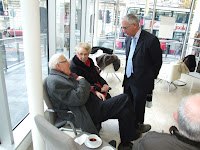 |
| Chris Spurr |
Chris Spurr, Chairman of the Ulster History Circle, welcomed everyone to this special occasion, the latest of the series of blue plaque in this part of the city. Jame Bryce was joining Luke Livingstone Macassey in Chichester Street, John Boyd Dunlop in May Street and Harry Ferguson in Donegall Square East. James Bryce's many achievement during his long life were impressive; historian, politician and diplomat. Although he lived in a very different age from our own his achievements remain exemplary in the present time. He was of course of Scottish stock who became one of the most prominent Ulster-Scots of Edwardian times. On this, the 175th anniversary of his birth in this street, it was fitting that we now have a visible and permanent record of his life and achievements here in Belfast. Since the early 1980s, the Ulster History Circle has put up more than 150 plaques all over Northern Ireland to celebrate the achievements of those men and women who have contributed significantly to our history, locally, nationally, and internationally. It is an entirely voluntary organisation, and relies on the support of local authorities, individuals, organisations, and businesses to fund the plaques. Chris extended his thanks to the Ulster-Scots Agency for its financial support for the plaque and for hosting the refreshments later and in particular he thanked Maynard Hanna of the Agency for all his help and support during the planning process. He also thanked Noel Phoenix and Clive Neville, joint owners of the building, for allowing the erection of the plaque there.
 |
| Ian Crozier |
Ian Crozier, CEO of the Ulster-Scots Agency, thanked the Circle for undertaking the project. This was the first of five plaques that the Circle would erect this year to commemorate Ulster-Scots people who had made a significant contribution not only here but internationally. He hoped this co-operation would continue into the future. Ulster people are a very forward looking people, always looking for the next challenge but one thing they are not so good at is recognising and celebrating their achievements and bringing them to the attention of the next generation as an inspiration. Over the next few years the Agency and the Circle would be working to bring such achievers to public recognition. Today we are honouring James Bryce. There were other Ulster-Scots like Lord Kelvin, honoured in Scotland, buried in Westminster Abbey but virtually unrecognised by today's generation. Blue plaques are too small to record the full extent of the achievements of people like James Bryce. He would not deal in detail with Bryce's life and achievents. That would be provided by Gordon Lucy in the Agency HQ later. It was with great pleasure that he unveiled the plaque.
 |
| Dr Gordon Lucy |
Following refreshments in the Agency's premises Dr Gordon Lucy addressed the gathering. Over the course of a stimulating, entertaining and informative 20 minute talk he took us through Bryce's origins, birth and early childhood in Belfast and Glasgow and showed how his early promise was exemplified by his academic achievments. He described the origins of Bryce's liberalism and the development of his scholarship, his extensive travelling and impressive mountaineering skills as well as providing an insight into Bryce's political and diplomatic achievements.
For more information about James Bryce's life and achievements visit www.ulsterhistory.co.uk/bryce.html




















